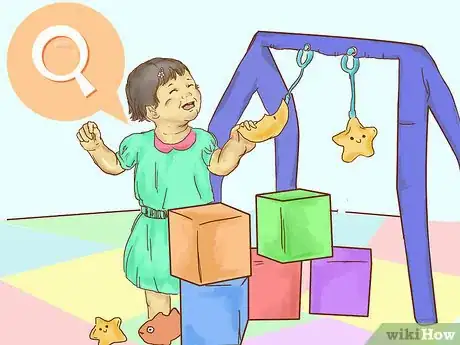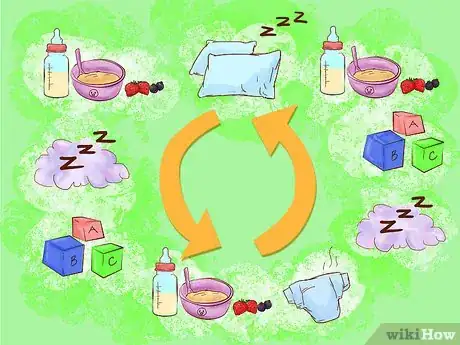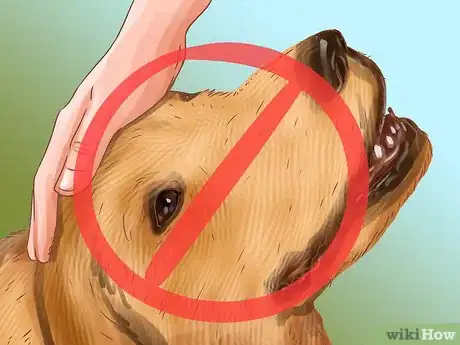This article was co-authored by Alexandra Janelli and by wikiHow staff writer, Christopher M. Osborne, PhD. Alexandra Janelli is a Certified Hypnotherapist, Anxiety & Stress Management Coach, and owner and founder of Modrn Sanctuary, a holistic health and wellness facility in Philadelphia, Pennsylvania. With over 10 years of experience, Alexandra specializes in helping clients push through their roadblocks to achieve their goals using her hypnotherapeutic approach. Alexandra holds a BS from the University of Miami. She graduated from the Hypnosis Motivation Institute with an Advanced Training Graduate Diploma in Hypnotherapy and Handwriting Analysis. Alexandra is also a Certified Life Coach from the iPEC Coach Training Program. She has worked with Academy Award Nominee Actors, world-renowned photographers, singers, top-level executives, and professionals across many sectors of business. Alexandra has been featured on MTV, Elle Magazine, Oprah Magazine, Men's Fitness, Swell City Guide, Dossier Journal, The New Yorker, and Time Out Chicago.
There are 15 references cited in this article, which can be found at the bottom of the page.
This article has been viewed 9,084 times.
Separation anxiety can cause clinginess when a loved one is around and distress when they’re away, but it's a condition that you can successfully manage. You might experience it yourself, or be caring for a child, baby, or pet with it. In any case, you should seek the assistance of medical professionals who can help to properly diagnose and offer appropriate treatment options. A positive, supportive attitude is also essential in every case of separation anxiety.
Steps
Managing Your Own Separation Anxiety
-
1Get a diagnosis and treatment from medical professionals. Separation anxiety can affect people of any age, and adults may be diagnosed with Adult Separation Anxiety Disorder (ASAD). Especially if you’re a teen or adult, your doctor may recommend treatments including:[1]
- Therapy sessions with a mental health professional.
- Joining a support group with others dealing with separation anxiety.
- Medications that may help you manage anxiety or depression.
-
2Use techniques to reframe your negative thoughts. As part of your therapy sessions, you’ll be given guidance on how to identify, confront, and overcome the negative thoughts that occur when you feel isolated or abandoned. Work with your therapist on your ability to do the following:[2]
- Try to think about the root of your separation anxiety. Was there something that happened in your life that made you feel unsafe, insecure or scared? You can't work through those anxious feelings until you start understanding where they came from.[3]
- Identify and write down the negative thoughts you experience.
- Replace negative thoughts with positive ones—for instance, making “I’ll never see him again” into “I will see him next week after his business trip.”
- Distract yourself from negative thoughts with enjoyable, healthy activities.
Advertisement -
3Try coping techniques to handle your anxious feelings. Sometimes, you won’t be able to reframe or ignore negative feelings. Your therapist will help you find coping strategies that work best for you. Possible examples include:[4]
- Deep-breathing exercises.
- Meditation.
- Visualization techniques.
- Yoga.
-
4Use exposure therapy if recommended by your therapist. In basic terms, exposure therapy involves “facing your fear,” but in a safe and supportive environment. Exposure therapy for separation anxiety might include activities like:[5]
- Imagining separation from loved ones during therapy sessions.
- Doing increasing periods of separation while you utilize coping strategies.
- Talking about your feelings during and after exposure therapy sessions.
Addressing Separation Anxiety in Children
-
1Observe their behaviors and get a proper medical diagnosis. All children experience at least mild separation anxiety at times. However, if even the very thought of separation causes severe emotional or physical symptoms, allow their doctor to do an evaluation of their condition.[6]
- A child with separation anxiety may do several of the following to avoid separations: throw tantrums; describe (real or imagined) physical illnesses like stomach pain or a bellyache; become excessively clingy when you’re around; become unable to sleep alone.
- About 4% of children between ages 7 and 10 have separation anxiety to a degree that warrants a clinical diagnosis.[7]
-
2Prepare them for time apart with books, games, and role playing. Fear of the unknown is one of the major factors behind childhood separation anxiety. Prepare them for the experience of separation in a calm, supportive manner, using techniques such as the following:[8]
- Reading children’s books that describe events like going to school for the first time.
- Playing games ranging from peek-a-boo to hide-and-seek.
- Role-playing together what a separation event, like staying at Grandma’s house for the weekend, will be like.
- Doing practice runs of getting ready and going to school.
-
3Create routines for separations and when you reunite. Regular, predictable routines offer the comfort of familiarity to children with separation anxiety. Develop and stick to steady routines for events such as:[9]
- Getting ready for bed and waking up in the morning.
- Heading off to school and returning home at the end of the day.
- Your departure for work and arrival back home.
-
4Stay positive and supportive at all times. Separation anxiety can be frustrating as a parent or caregiver, but getting upset will not help matters. Never scold the child, tell them they’re acting “like a baby” or need to be “big boy” or “big girl,” or minimize their feelings in other ways.[10]
- Also, never make promises you can’t keep: for instance, “I promise, if you calm down so I can go to work today, I’ll stay home tomorrow.”
- Instead, validate their feelings and offer your support: “I know it makes you sad when I go to work. I feel sad too. Let’s both draw a picture that the other person can keep while I’m at work.”
Handling Infant Separation Anxiety
-
1Don’t avoid the issue by surrendering to their anxiety. When you’re sleep-deprived and stressed out as the caregiver for an infant, it’s easy to cave in to their cries and wails. However, if you avoid their separation anxiety by sleeping with them or staying home all the time, they’ll never have a reason to overcome it.[11]
- Instead, do things like making brief check-ins when they cry at night, and doing daytime separations of increasing duration while another familiar caregiver is present.
-
2Remain positive during departures and reunions. Instead of making separations feel like a sad event that everyone has to muddle through, treat them as normal parts of a happy day. Even if you feel terrible leaving them, don’t show it![12]
- When you leave, talk enthusiastically about all the fun they’ll have with their caregiver, and assure them that you’ll be back.
- When you come back, smile broadly, embrace them, and spend some quality time together.
-
3Give them opportunities to explore and play independently. Let your infant play in a safe and secure play swing with gadgets hanging down, or let them crawl or toddle around in a safe room filled with age-appropriate items to explore. Stay close enough that you can see and hear them, but don’t hover over them.[13]
- This will help them realize that they can have fun without you being right there with them.
- With infants and toddlers, “independence” is a relative term. Keep the child in sight at all times, and make sure any room they’re in is properly baby-proofed.
-
4Create consistent daytime and nighttime routines. Consistency fosters a sense of security in people of all ages, including infants. Familiar rituals signal that it’s time to play with Grandpa, or to nap, or for you to go to work, and reduce anxiety about changes or differences.[14]
- By reducing your infant’s overall anxiety, you’ll help to reduce their experience of separation anxiety.
- Your child will learn, for instance, that the before-nap routine is always followed by the after-nap routine, which can help soothe their anxiety about the nap itself.
Dealing with Separation Anxiety in Pets
-
1Spend quality time with your cat, dog, or other pet. Pets often experience separation anxiety because they simply aren’t getting enough attention when you are around. Spend at least an hour each day actively engaged with your pet, whether by playing, going for a walk, or petting and talking to it while you cuddle up on the sofa.[15]
- Dogs are usually eager for any type of attention you can give, while cats can be more picky and apparently indifferent. Be prepared to follow the cat’s lead regarding when and how to shower it with attention!
-
2Give your pet lots to do while you’re gone. If your pet keeps busy with enriching activities while you’re away, it will be less likely to experience loneliness or anxiety. Depending on your pet, try things like the following:[16]
- Puzzle toys that require them to work for a treat.
- Chew toys or scratching posts.
- Music to listen to while you’re away.
- Perches, playhouses, towers, caves, etc.
-
3Don’t make a big deal out of your departures or arrivals. If you feel anxious or sad about leaving your pet, it might pick up on this and experience more anxiety on its end. Instead, treat your departures like they’re no big deal, with a minimum of fuss—maybe just a quick pet and a simple “Goodbye—I’ll see you soon.”[17]
- You can show enthusiasm when you return, but don’t make it seem like it was an impossible ordeal to be away for a few hours. Just take the opportunity to spend some quality time with your pet.
-
4Talk to your vet about treatment options. If you’re having trouble managing your pet’s separation anxiety, seek out your vet’s advice. They might recommend treatment options such as:[18]
- Leaving scented items (like clothing) behind for your pet.
- Using calming sprays or pheromones.
- Trying calming apparel, like shirts or collars.
- Giving your pet relaxation or anti-anxiety medications.
Expert Q&A
-
QuestionHow do you stop separation anxiety in pets?
 Alexandra JanelliAlexandra Janelli is a Certified Hypnotherapist, Anxiety & Stress Management Coach, and owner and founder of Modrn Sanctuary, a holistic health and wellness facility in Philadelphia, Pennsylvania. With over 10 years of experience, Alexandra specializes in helping clients push through their roadblocks to achieve their goals using her hypnotherapeutic approach. Alexandra holds a BS from the University of Miami. She graduated from the Hypnosis Motivation Institute with an Advanced Training Graduate Diploma in Hypnotherapy and Handwriting Analysis. Alexandra is also a Certified Life Coach from the iPEC Coach Training Program. She has worked with Academy Award Nominee Actors, world-renowned photographers, singers, top-level executives, and professionals across many sectors of business. Alexandra has been featured on MTV, Elle Magazine, Oprah Magazine, Men's Fitness, Swell City Guide, Dossier Journal, The New Yorker, and Time Out Chicago.
Alexandra JanelliAlexandra Janelli is a Certified Hypnotherapist, Anxiety & Stress Management Coach, and owner and founder of Modrn Sanctuary, a holistic health and wellness facility in Philadelphia, Pennsylvania. With over 10 years of experience, Alexandra specializes in helping clients push through their roadblocks to achieve their goals using her hypnotherapeutic approach. Alexandra holds a BS from the University of Miami. She graduated from the Hypnosis Motivation Institute with an Advanced Training Graduate Diploma in Hypnotherapy and Handwriting Analysis. Alexandra is also a Certified Life Coach from the iPEC Coach Training Program. She has worked with Academy Award Nominee Actors, world-renowned photographers, singers, top-level executives, and professionals across many sectors of business. Alexandra has been featured on MTV, Elle Magazine, Oprah Magazine, Men's Fitness, Swell City Guide, Dossier Journal, The New Yorker, and Time Out Chicago.
Certified Hypnotherapist & Anxiety and Stress Management Coach Try desensitizing your pet to your departures by leaving for about 2 minutes, then coming back in. Gradually work up to longer periods of time.
Try desensitizing your pet to your departures by leaving for about 2 minutes, then coming back in. Gradually work up to longer periods of time. -
QuestionWhat is the best treatment for separation anxiety?
 Alexandra JanelliAlexandra Janelli is a Certified Hypnotherapist, Anxiety & Stress Management Coach, and owner and founder of Modrn Sanctuary, a holistic health and wellness facility in Philadelphia, Pennsylvania. With over 10 years of experience, Alexandra specializes in helping clients push through their roadblocks to achieve their goals using her hypnotherapeutic approach. Alexandra holds a BS from the University of Miami. She graduated from the Hypnosis Motivation Institute with an Advanced Training Graduate Diploma in Hypnotherapy and Handwriting Analysis. Alexandra is also a Certified Life Coach from the iPEC Coach Training Program. She has worked with Academy Award Nominee Actors, world-renowned photographers, singers, top-level executives, and professionals across many sectors of business. Alexandra has been featured on MTV, Elle Magazine, Oprah Magazine, Men's Fitness, Swell City Guide, Dossier Journal, The New Yorker, and Time Out Chicago.
Alexandra JanelliAlexandra Janelli is a Certified Hypnotherapist, Anxiety & Stress Management Coach, and owner and founder of Modrn Sanctuary, a holistic health and wellness facility in Philadelphia, Pennsylvania. With over 10 years of experience, Alexandra specializes in helping clients push through their roadblocks to achieve their goals using her hypnotherapeutic approach. Alexandra holds a BS from the University of Miami. She graduated from the Hypnosis Motivation Institute with an Advanced Training Graduate Diploma in Hypnotherapy and Handwriting Analysis. Alexandra is also a Certified Life Coach from the iPEC Coach Training Program. She has worked with Academy Award Nominee Actors, world-renowned photographers, singers, top-level executives, and professionals across many sectors of business. Alexandra has been featured on MTV, Elle Magazine, Oprah Magazine, Men's Fitness, Swell City Guide, Dossier Journal, The New Yorker, and Time Out Chicago.
Certified Hypnotherapist & Anxiety and Stress Management Coach It helps to try to understand where that fear is coming from. Is there a time you felt unsafe, insecure, or scared? It can help to do coaching work to get down to the root of that.
It helps to try to understand where that fear is coming from. Is there a time you felt unsafe, insecure, or scared? It can help to do coaching work to get down to the root of that.
References
- ↑ https://www.mayoclinic.org/diseases-conditions/anxiety/diagnosis-treatment/drc-20350967
- ↑ https://www.uwhealth.org/health/topic/actionset/depression-stop-negative-thoughts/uf9919.html
- ↑ Alexandra Janelli. Certified Hypnotherapist & Anxiety and Stress Management Coach. Expert Interview. 27 August 2020.
- ↑ https://www.mayoclinic.org/diseases-conditions/anxiety/diagnosis-treatment/drc-20350967
- ↑ https://adaa.org/finding-help/treatment/therapy
- ↑ https://medlineplus.gov/ency/article/001542.htm
- ↑ http://www.adaa.org/living-with-anxiety/children/childhood-anxiety-disorders
- ↑ https://www.parents.com/toddlers-preschoolers/starting-preschool/separation-anxiety/the-cling-thing-how-to-ease-separation/
- ↑ https://www.parents.com/toddlers-preschoolers/starting-preschool/separation-anxiety/the-cling-thing-how-to-ease-separation/
- ↑ https://www.parents.com/toddlers-preschoolers/starting-preschool/separation-anxiety/the-cling-thing-how-to-ease-separation/
- ↑ https://babysleepsite.com/sleep-training/baby-toddler-sleep-separation-anxiety/
- ↑ https://www.babycenter.com/0_separation-anxiety_145.bc?showAll=true
- ↑ http://www.babycenter.com/0_separation-anxiety_145.bc?showAll=true
- ↑ https://www.parents.com/baby/development/separation-anxiety/10-separation-strategies1/
- ↑ https://indoorpet.osu.edu//cats/basicneeds/toys
- ↑ https://drsophiayin.com/blog/entry/separation-anxiety-in-cats-when-a-smelly-surprise-means-kitty-loves-you/
- ↑ https://dogtime.com/dog-health/dog-behavior/36-separation-anxiety
- ↑ https://www.humanesociety.org/resources/does-your-dog-freak-out-when-you-leave#causes












































































Medical Disclaimer
The content of this article is not intended to be a substitute for professional medical advice, examination, diagnosis, or treatment. You should always contact your doctor or other qualified healthcare professional before starting, changing, or stopping any kind of health treatment.
Read More...